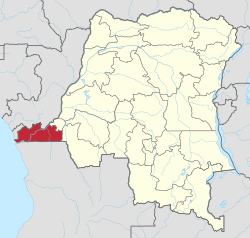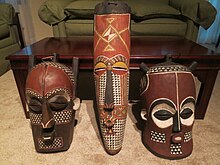Kongo Central
Kongo Central | |
|---|---|
| Province du Kongo Central | |
 | |
| Coordinates: 05°49′S 13°29′E / 5.817°S 13.483°ECoordinates: 05°49′S 13°29′E / 5.817°S 13.483°E | |
| Country | |
| Capital | Matadi |
| Largest city | Matadi |
| Government | |
| • Type | unicameral |
| • Body | Provincial Assembly of Kongo Central |
| • Governor | Atou Matubuana Nkuluki[1] |
| Area | |
| • Total | 53,920 km2 (20,820 sq mi) |
| Population (2015) | |
| • Total | 5,575,000 |
| • Density | 100/km2 (270/sq mi) |
| Demonym(s) | Bakongo |
| Time zone | UTC+1 (West Africa Time) |
| Official language | French |
| National languages | Kikongo ya Leta, lingala[2] |
| HDI (2017) | 0.432[3] low |
| Non-national language | Kikongo |
Kongo Central (Kongo: Kongo dia Kati [4][5]), formerly Bas-Congo is one of the 26 provinces of the Democratic Republic of the Congo.[6] Its capital is Matadi.
History[]
At the time of independence, the area now encompassing Kongo Central was part of the greater province of Léopoldville, along with the capital city of Kinshasa and the districts of Kwango, Kwilu and Mai-Ndombe. Under Belgian colonial rule, the province was known as Bas-Congo (as in "Lower Congo River") and was renamed Kongo Central after independence.[7][8]
Under the regime of Mobutu Sese Seko from 1965 to 1997, the Congo river was renamed as Zaire. The province was named as Bas-Zaïre. The name was later reverted to Bas-Congo. It was subsequently renamed as Kongo Central in 2015.
Geography[]


Kongo Central is the only province in the country with an ocean coastline; it has narrow frontage on the Atlantic Ocean. It borders the provinces of Kinshasa to the north-east, Kwango to the east, and the Republic of Angola to the south as well as the Republic of the Congo and Cabinda to the north.
Divisions[]
This section's factual accuracy may be compromised due to out-of-date information. The reason given is: provinces are now divided into cities and territories - no districts. (April 2019) |
The provincial capital is Matadi. The only other official city is Boma. The remainder of the province is divided into the districts of Bas-Fleuve, Cataractes and Lukaya. Towns with their 2010 populations are:
Notable residents[]
Writer Zamenga Batukezanga was born in Kongo Central.
References[]
- ^ Mansianga, Fonseca (29 November 2019). . ACTUALITE.CD (in French). Retrieved 4 December 2019.
- ^ "Kongo-central : le kikongo en voie de disparition, le lingala gagne progressivement du terrain [Enquête]". L'Opinion Info (in French).
Le lingala est fortement utilisé dans les milieux des enfants et des jeunes, tandis que le Kikongo est principalement utilisé chez les vieilles personnes.
[Lingala is used extensively among children and youth, while Kikongo is used primarily among older people.] - ^ "Sub-national HDI - Area Database - Global Data Lab". hdi.globaldatalab.org. Retrieved 2018-09-13.
- ^ M. J. Hambrey and W. B. Harland, Earth's Pre-Pleistocene Glacial Record, Cambridge University Press, 2011, p. 157
- ^ Godefroid Muzalia Kihangu, Bundu dia Kongo, une résurgence des messianismes et de l’alliance des Bakongo?, Universiteit Gent, België, 2011, p. 1
- ^ Central Intelligence Agency (2016). "Democratic Republic of the Congo". The World Factbook. Langley, Virginia: Central Intelligence Agency. Retrieved 10 May 2016.
- ^ "Constitution de la République Démocratique du Congo du 1er août 1964" [Constitution of the Democratic Republic of the Congo of 1 August 1964]. Global Legal Information Network (in French). 1964. Archived from the original on 2 August 2012. Retrieved 22 May 2012. (Article 4)
- ^ "Constitution de la République Démocratique du Congo du 24 juin 1967" [Constitution of the Democratic Republic of the Congo of 24 June 1967]. Global Legal Information Network (in French). 1967. Archived from the original on 2 August 2012. Retrieved 22 May 2012. (Article 1)
- ^ Jump up to: a b "Bas-Congo: largest cities and towns and statistics of their population". World Gazetteer. Archived from the original on 2012-12-16.
Bibliography[]
| Wikimedia Commons has media related to Kongo Central. |
- Gillet, J. (1927) Catalogue des plantes du jardin d'essais de la mission de Kisantu. Bruxelles 166 pp.
- Pauwels, L. (1993) Nzayilu N'ti – guide des arbres et arbustes de la région de Kinshasa – Brazzaville. Meise ISBN 9072619102, 495 pp.
- Latham, P. (2003) Edible caterpillars and their food plants in Bas-Congo Mystole Publications. ISBN 0954301277, 60 pp.
- Kibungu Kembelo, A.O. (2004) Plantes medicinales du Bas-Congo et leurs usages DFID. 197 pp.
- Latham, P. (2004) Useful plants of Bas-Congo province DFID. ISBN 0954669835, 320 pp.
- Latham, P. (2008) Les chenilles comestibles et leurs plantes nourricières dans la province du Bas-Congo DFID. ISBN 9780955420863,44 pp.
- Latham, P. et Konda ku Mbuta, A. (2010) Plantes utiles du Bas-Congo. Mystole Publications. ISBN 9780955420818, 372 pp.
- Latham, P. et Konda ku Mbuta, A. (2011) Some honeybee plants of Bas-Congo province DFID. ISBN 9780955420894, 248 pp.
- Latham, P. & Konda ku Mbuta, A. (2014) Useful plants of Bas-Congo province ISBN 9780955420870, 553 pp.
- Kongo Central
- Provinces of the Democratic Republic of the Congo
- 1962 establishments in the Republic of the Congo (Léopoldville)
- States and territories established in 1963
- Geopolitical corridors
